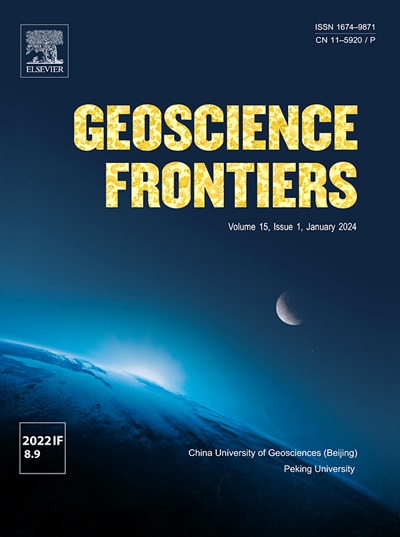Stepwise aridification of the Late Paleozoic North China Craton
IF 8.9
1区 地球科学
Q1 GEOSCIENCES, MULTIDISCIPLINARY
引用次数: 0
Abstract
The Late Paleozoic marked Earth’s most recent icehouse–greenhouse transition, providing valuable insights into future climate and environmental changes. Although the aridification of the North China Craton (NCC) during the Late Paleozoic is well established, its pattern and causes remain unclear. Here, we identify four aridification intervals from the late Gzhelian to Lopingian by analyzing continuous records of elemental climate proxies (MgO/CaO, Sr/Cu), a volcanism proxy (Hg/TOC), and spore–pollen assemblages. Interval I (∼303–295 Ma), during which the NCC was located at low paleolatitudes, was characterized by humid conditions and a predominance of ferns, associated with weak volcanism. Interval II (∼295–286 Ma) was subhumid, with increasing gymnosperm presence, and significant climate fluctuations linked to volcanism. CO2 emissions from the Tarim LIP and Panjal Traps drove aridification from the late Asselian to late Artinskian, contributing to the decline of the Late Paleozoic Ice Age. As a result, aridification in the NCC lagged behind that of Pangea. Interval III (∼286–280.98 Ma) marked the transition to subarid conditions and the onset of dominance by gymnosperms, associated with a rapid northward drift of the NCC and an increase in atmospheric ρCO2. Interval IV (∼259.51–251.902 Ma), separated from the underlying Interval III by a major regional unconformity (∼280.98–259.51), coincided with global aridification and intensified volcanism. These findings highlight the significant influences of both tectonic plate motion and volcanism on the climate evolution of the NCC, with shifts in the dominant controlling factors through time. This study provides new insights into the distinct trajectories of global and regional climate dynamics.

晚古生代华北克拉通的逐步干旱化
晚古生代标志着地球最近的冰-温室转变,为未来的气候和环境变化提供了有价值的见解。华北克拉通晚古生代干旱化作用虽已确定,但其模式和成因仍不清楚。本文通过分析连续记录的元素气候指标(MgO/CaO、Sr/Cu)、火山作用指标(Hg/TOC)和孢粉组合,确定了晚至洛平纪的4个干旱化期。区间1 (~ 303 ~ 295 Ma), NCC位于古低纬度,气候湿润,蕨类植物占优势,伴有弱火山作用。区间II (~ 295-286 Ma)是半湿润的,裸子植物的存在增加,并且与火山活动有关的显著气候波动。塔里木盆地和潘加尔圈闭的CO2排放推动了亚塞利晚期到阿廷斯基晚期的干旱化,导致了晚古生代冰期的衰落。因此,NCC的干旱化落后于盘古大陆。区间III (~ 286-280.98 Ma)标志着向亚干旱条件的过渡和裸子植物优势地位的开始,与NCC快速北移和大气中ρCO2的增加有关。区间IV (~ 259.51 ~ 251.902 Ma)与下伏区间III(~ 280.98 ~ 259.51)被一个主要的区域不整合区分开,与全球干化和火山活动加剧相吻合。这些发现强调了构造板块运动和火山活动对北大陆架气候演化的重要影响,并且随着时间的推移,主要的控制因素会发生变化。这项研究为全球和区域气候动力学的不同轨迹提供了新的见解。
本文章由计算机程序翻译,如有差异,请以英文原文为准。
求助全文
约1分钟内获得全文
求助全文
来源期刊

Geoscience frontiers
Earth and Planetary Sciences-General Earth and Planetary Sciences
CiteScore
17.80
自引率
3.40%
发文量
147
审稿时长
35 days
期刊介绍:
Geoscience Frontiers (GSF) is the Journal of China University of Geosciences (Beijing) and Peking University. It publishes peer-reviewed research articles and reviews in interdisciplinary fields of Earth and Planetary Sciences. GSF covers various research areas including petrology and geochemistry, lithospheric architecture and mantle dynamics, global tectonics, economic geology and fuel exploration, geophysics, stratigraphy and paleontology, environmental and engineering geology, astrogeology, and the nexus of resources-energy-emissions-climate under Sustainable Development Goals. The journal aims to bridge innovative, provocative, and challenging concepts and models in these fields, providing insights on correlations and evolution.
 求助内容:
求助内容: 应助结果提醒方式:
应助结果提醒方式:


